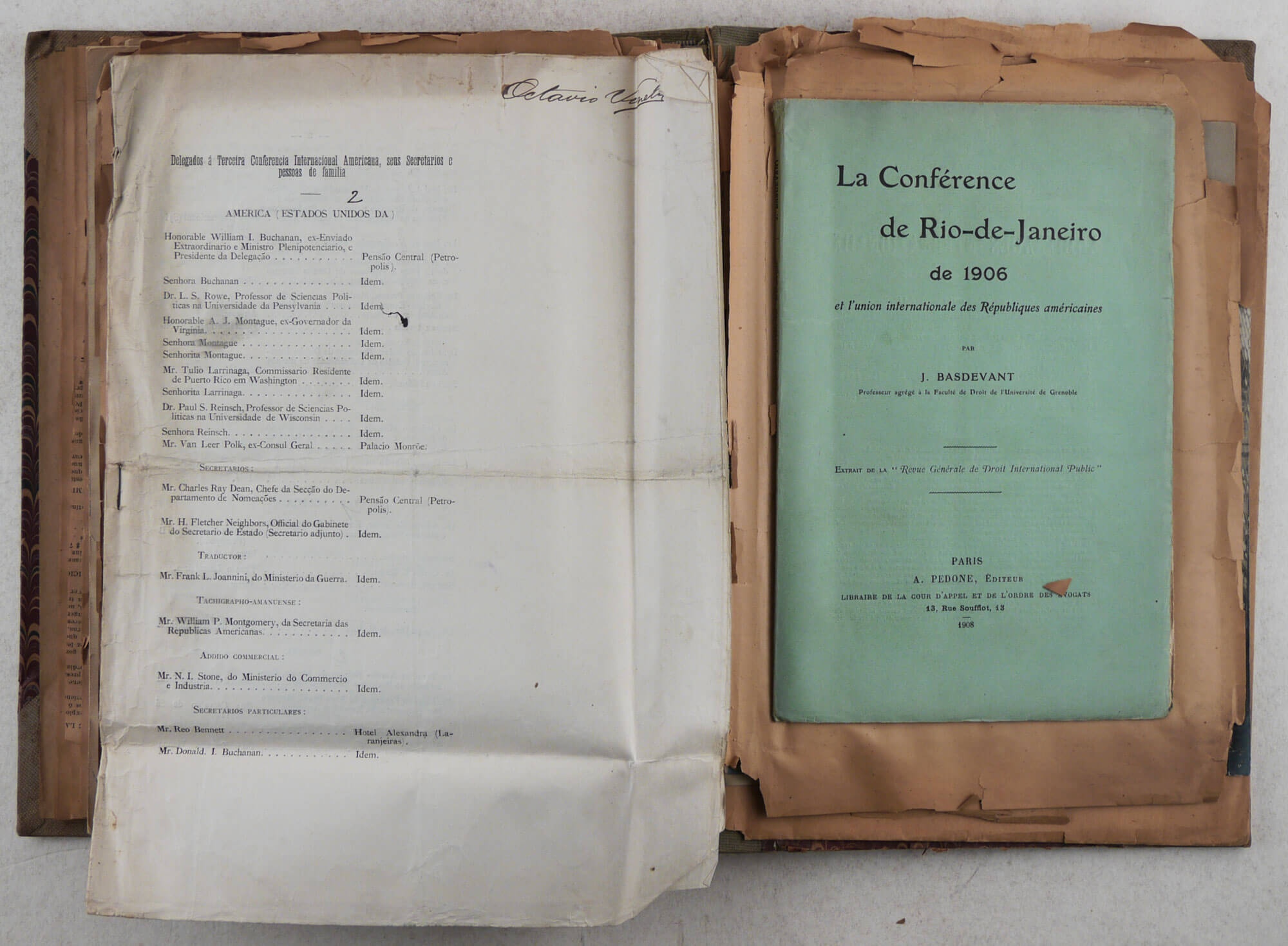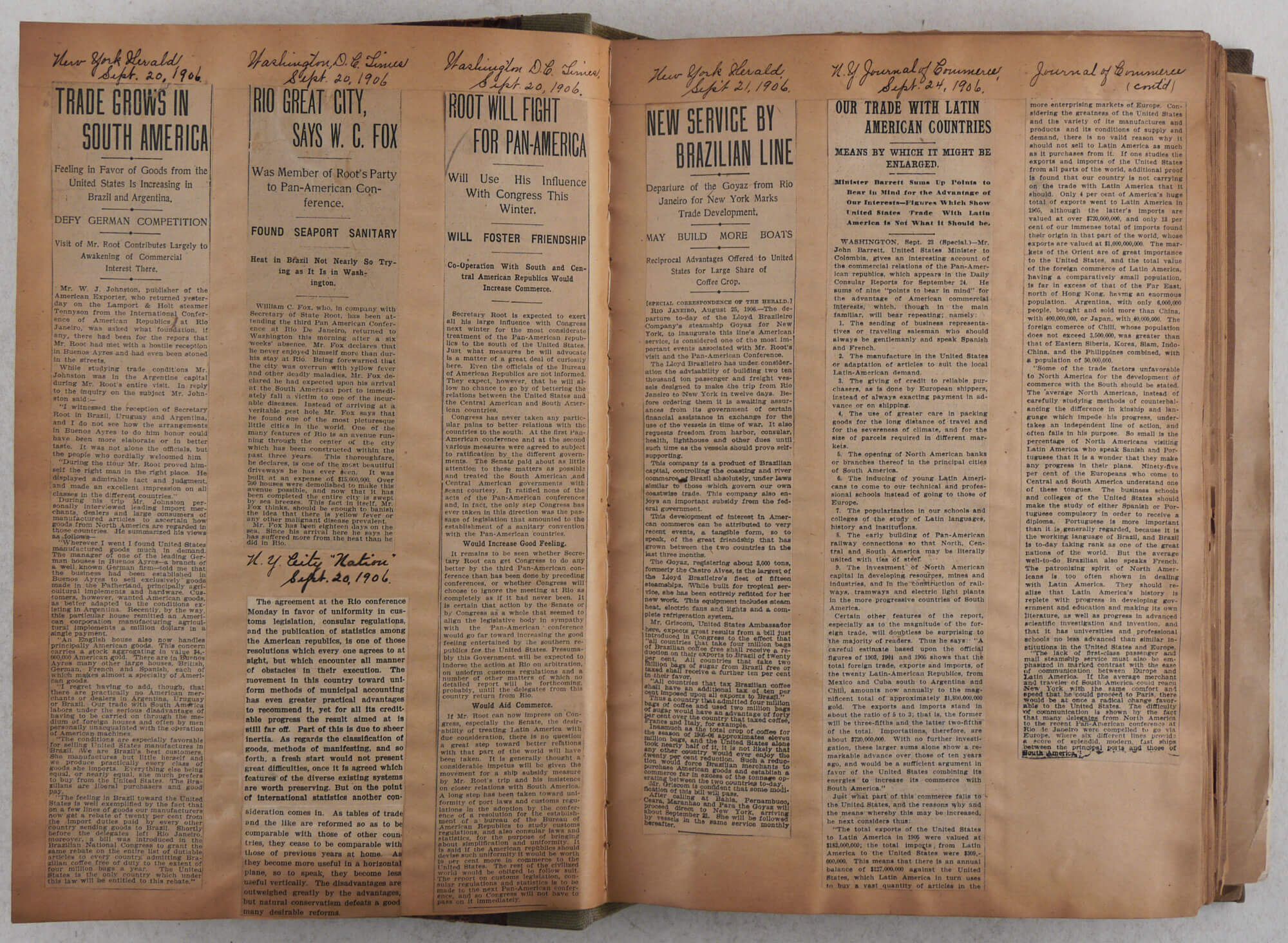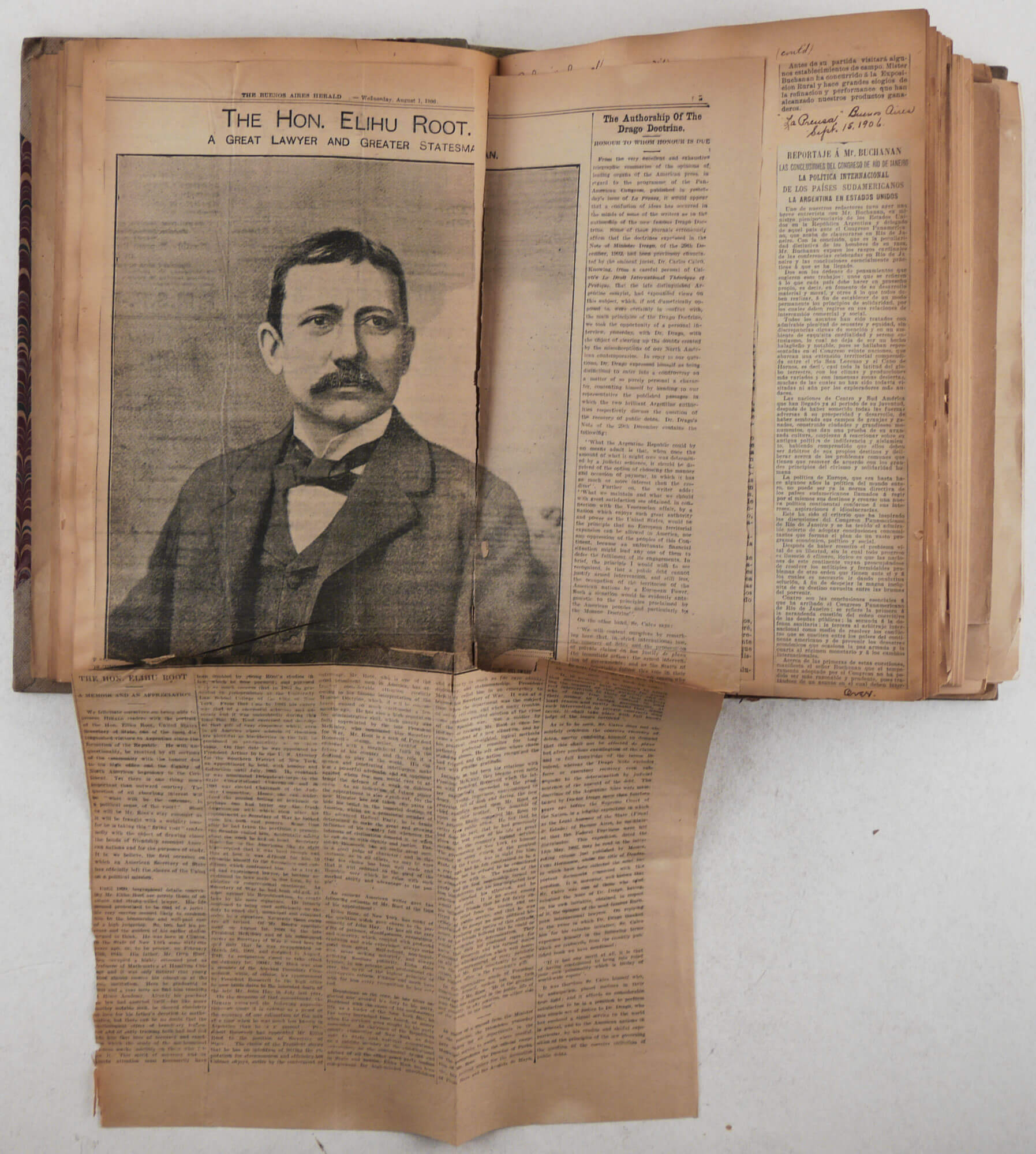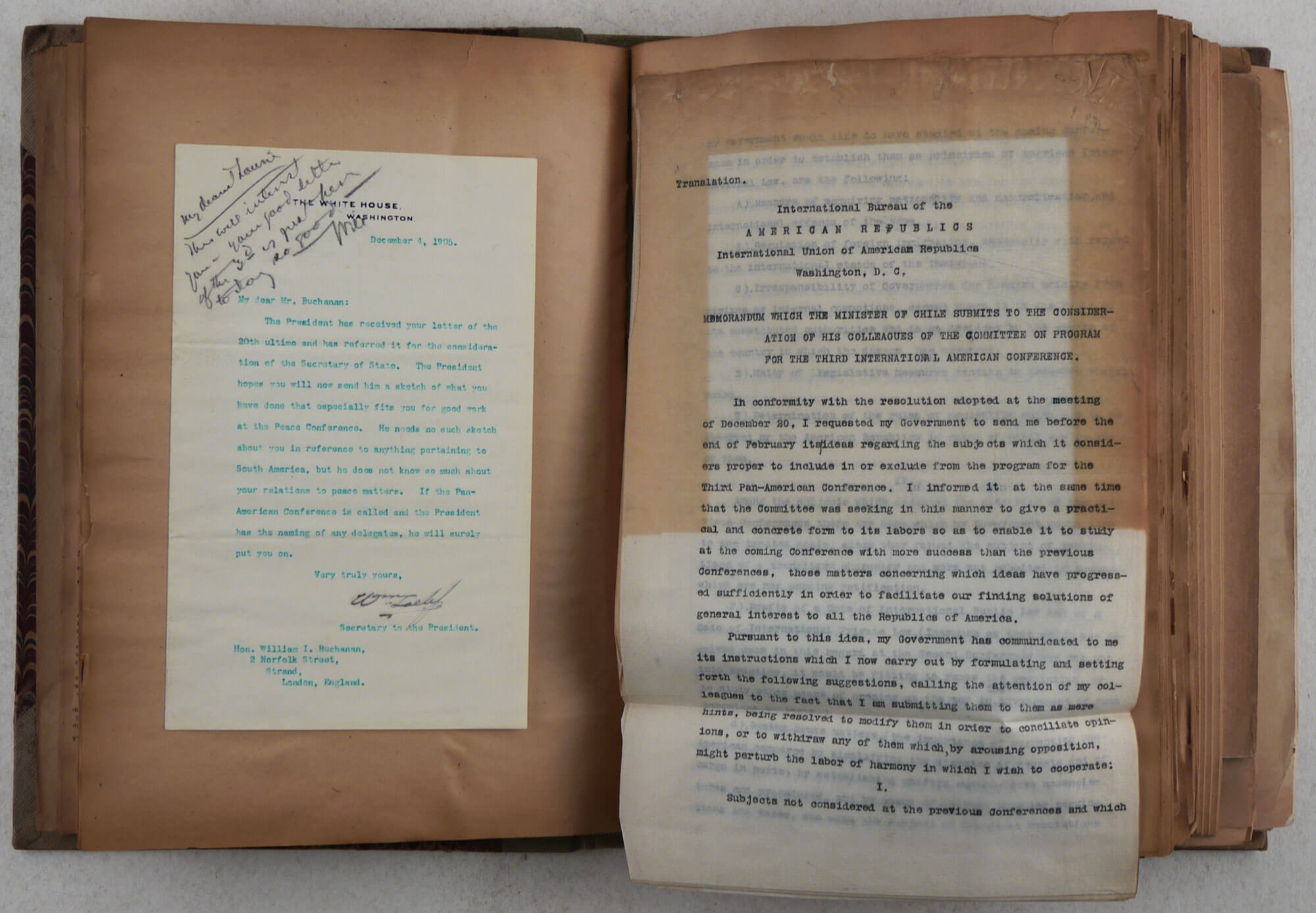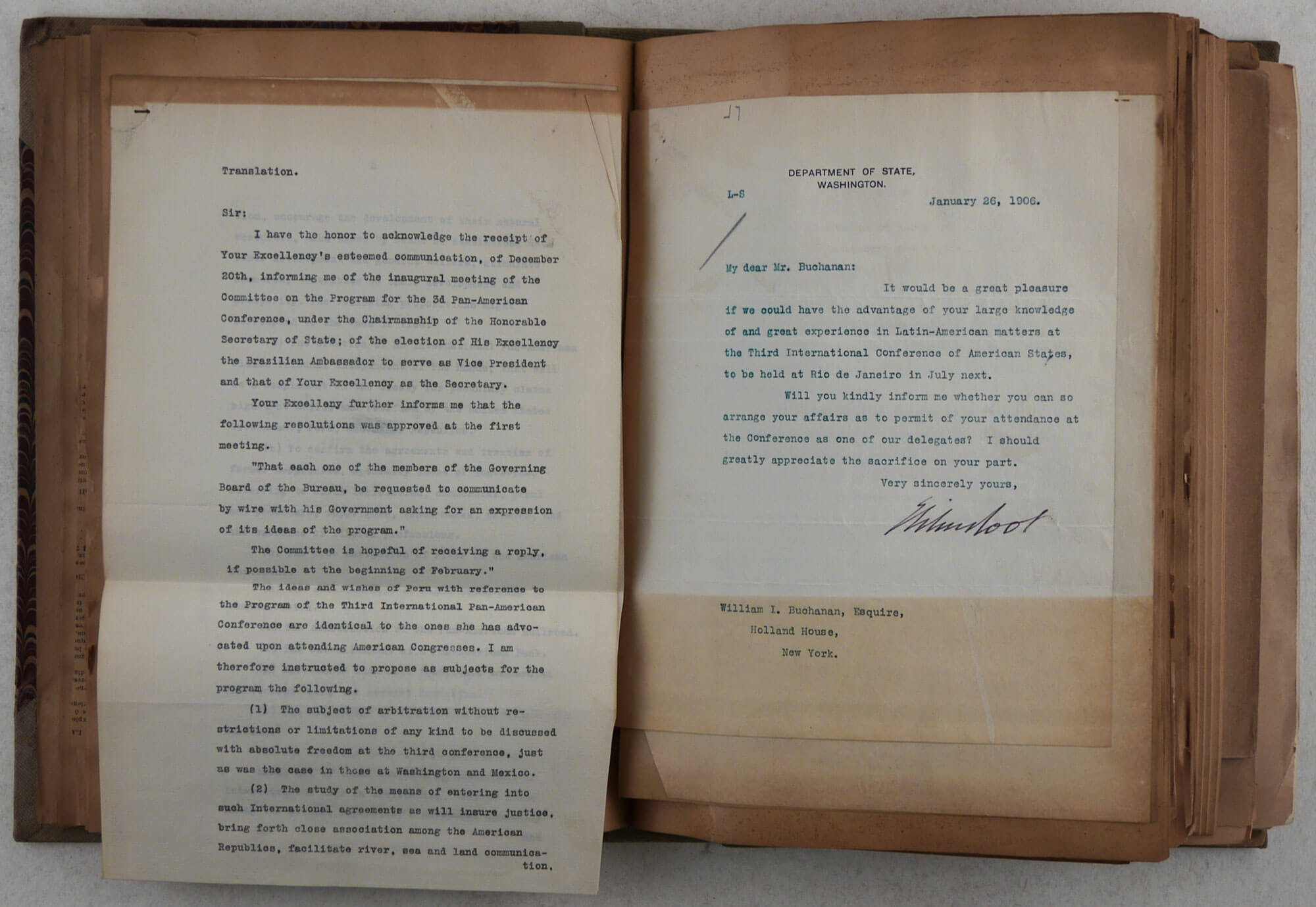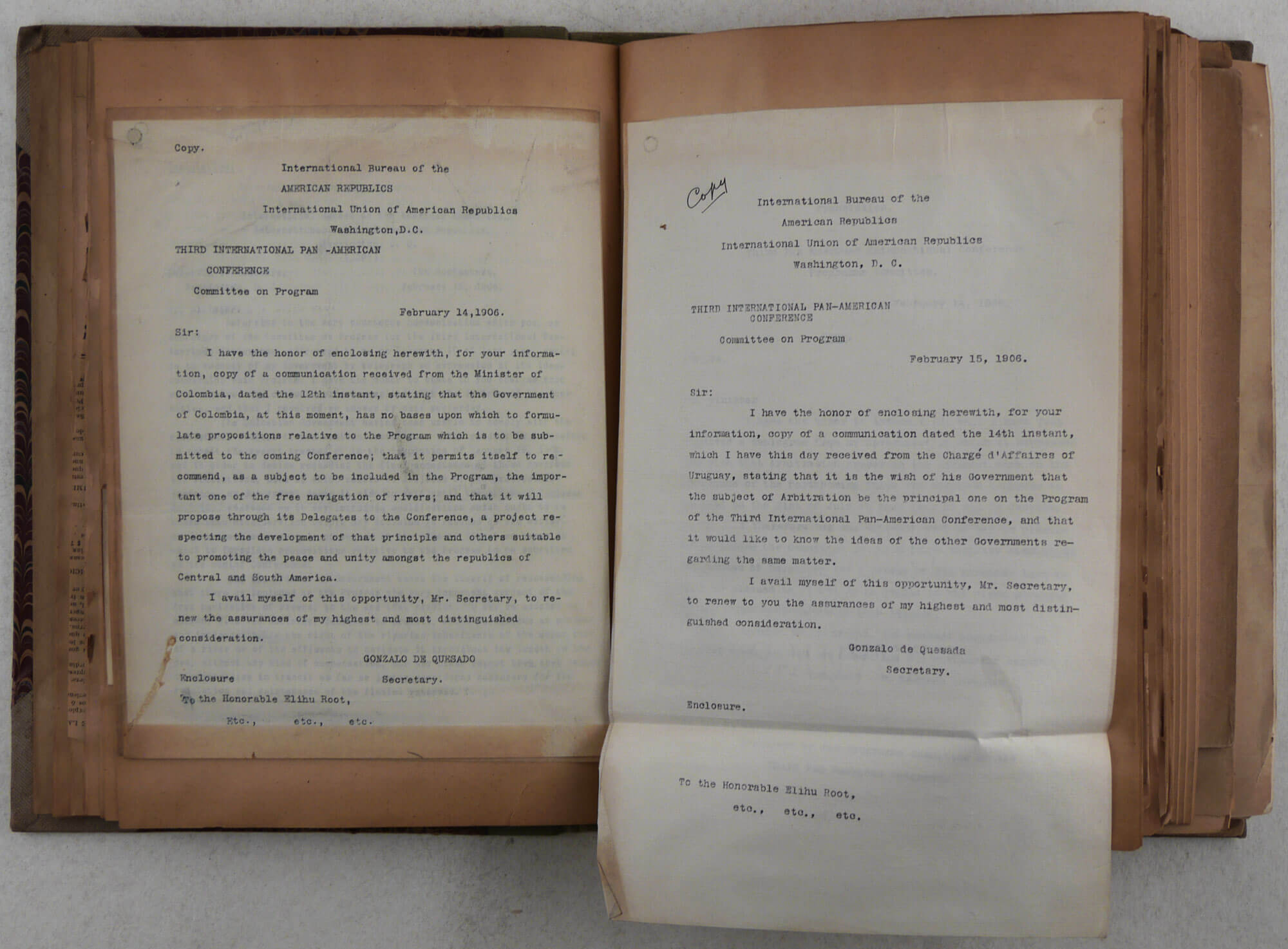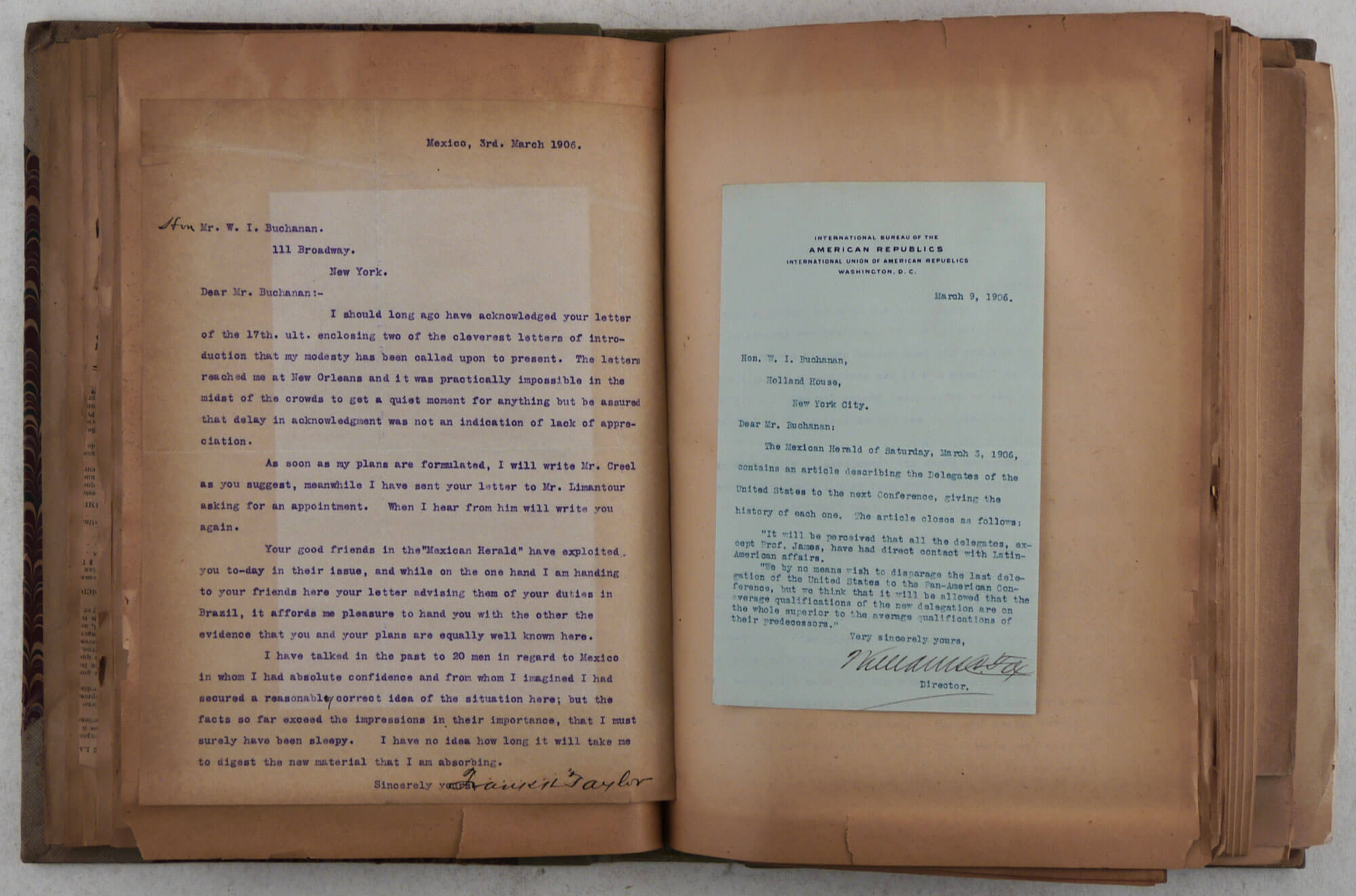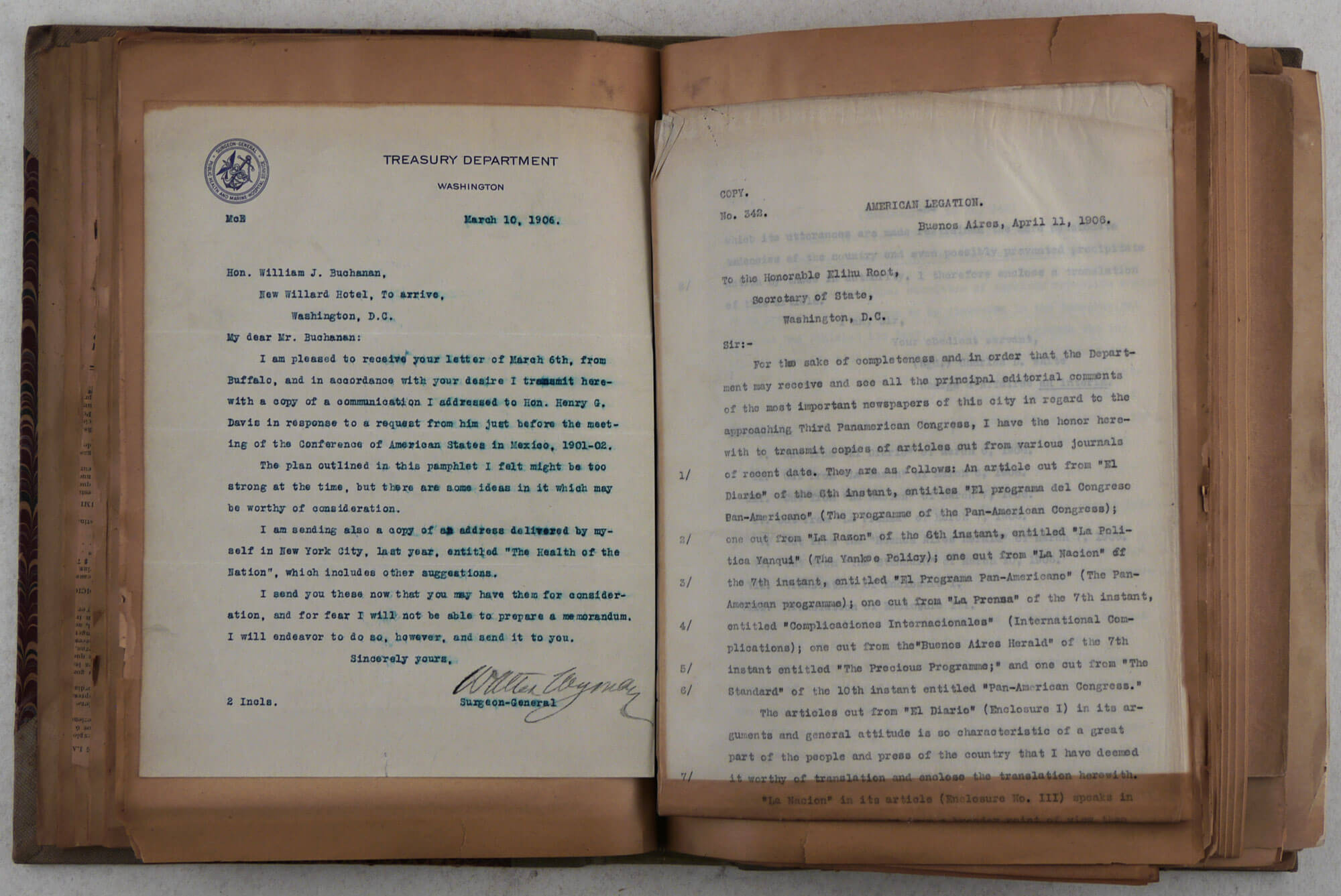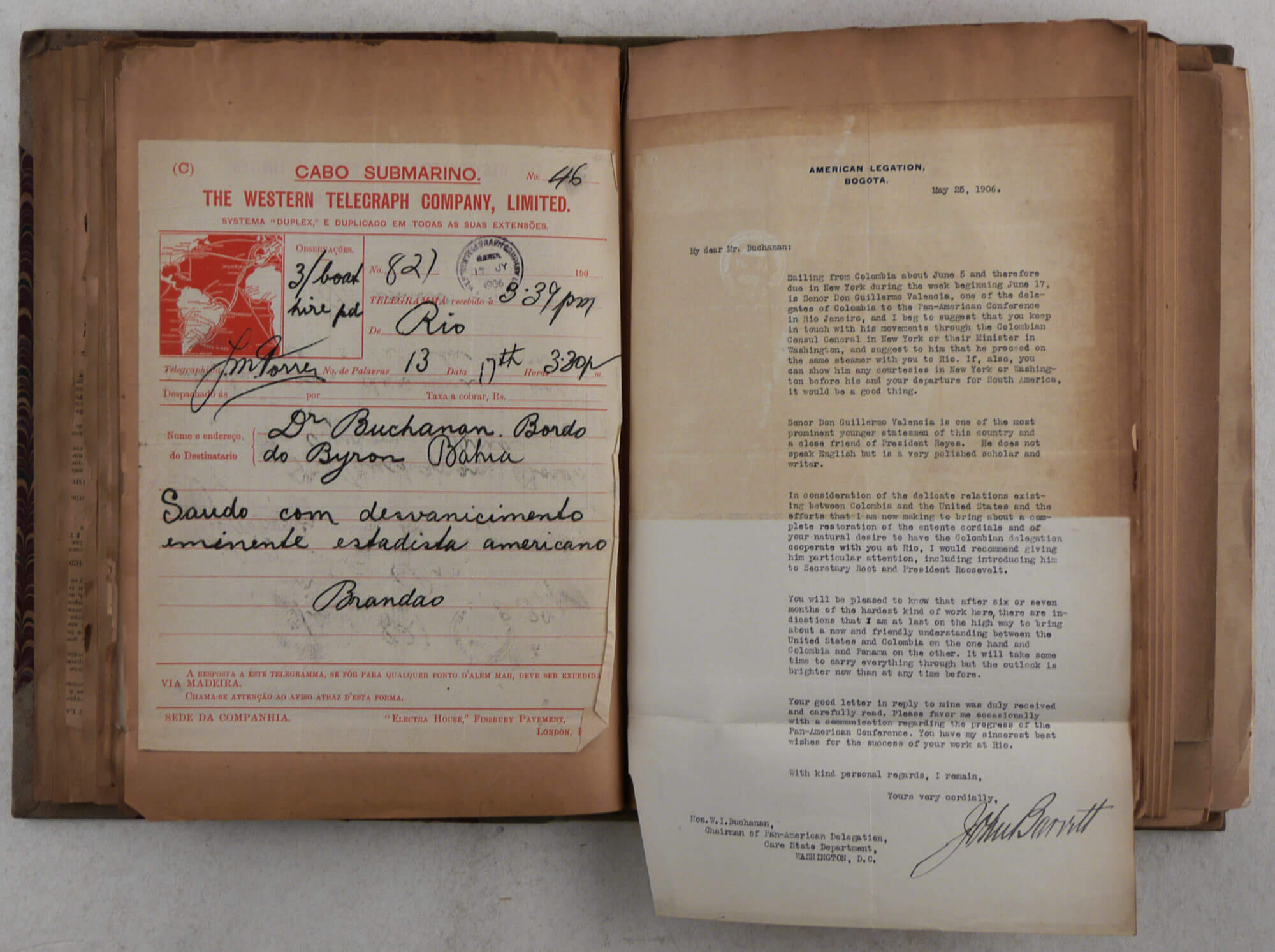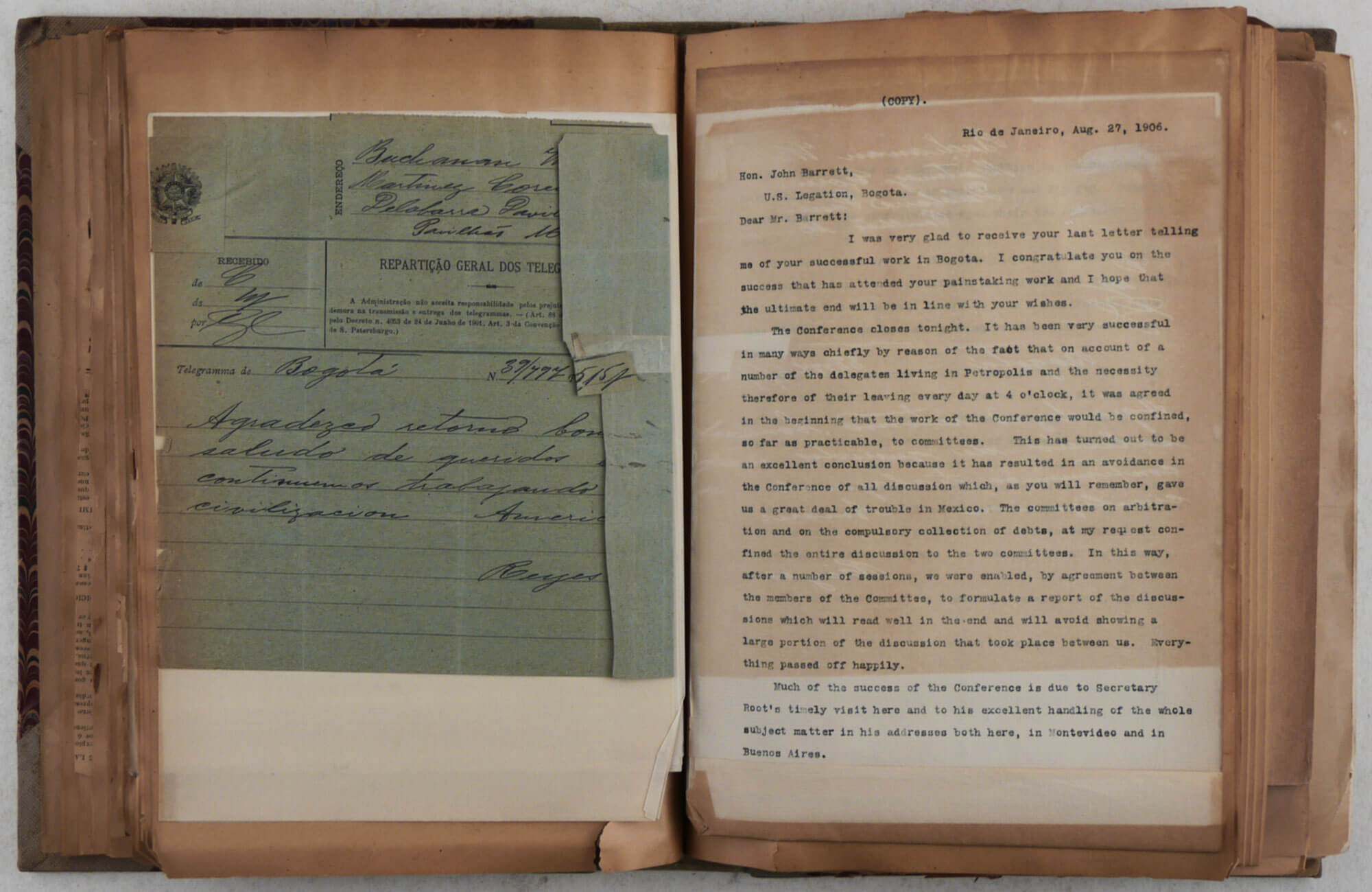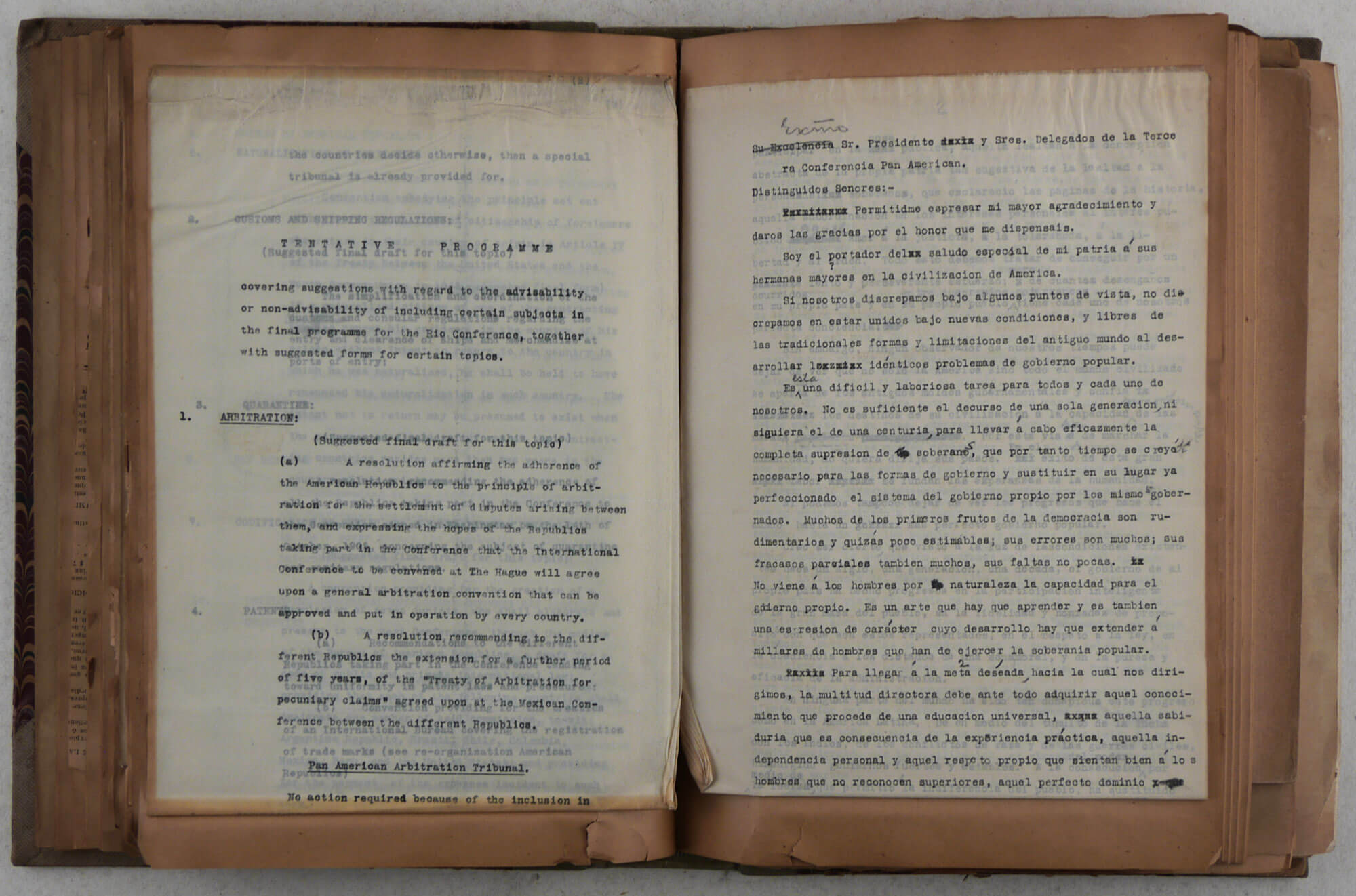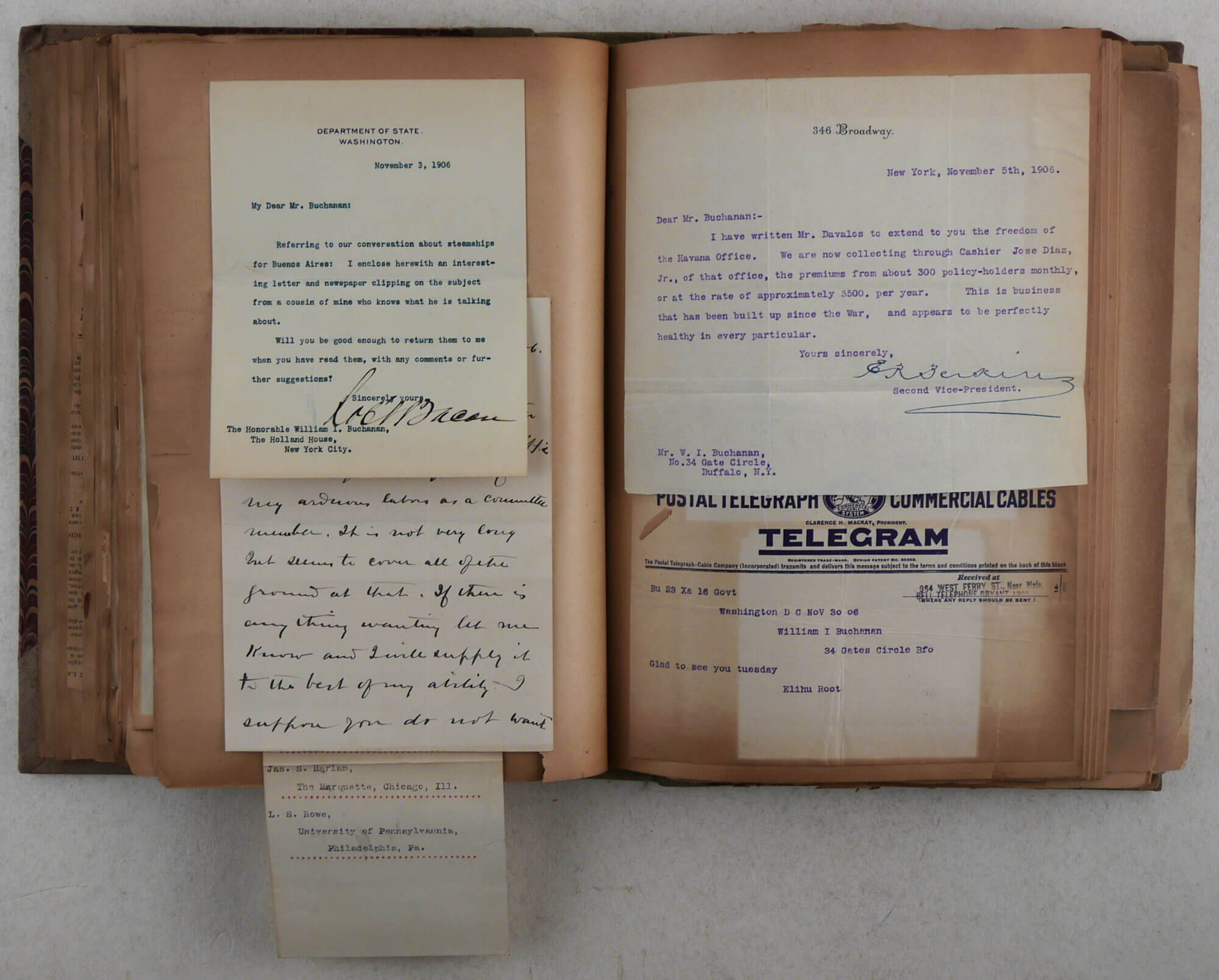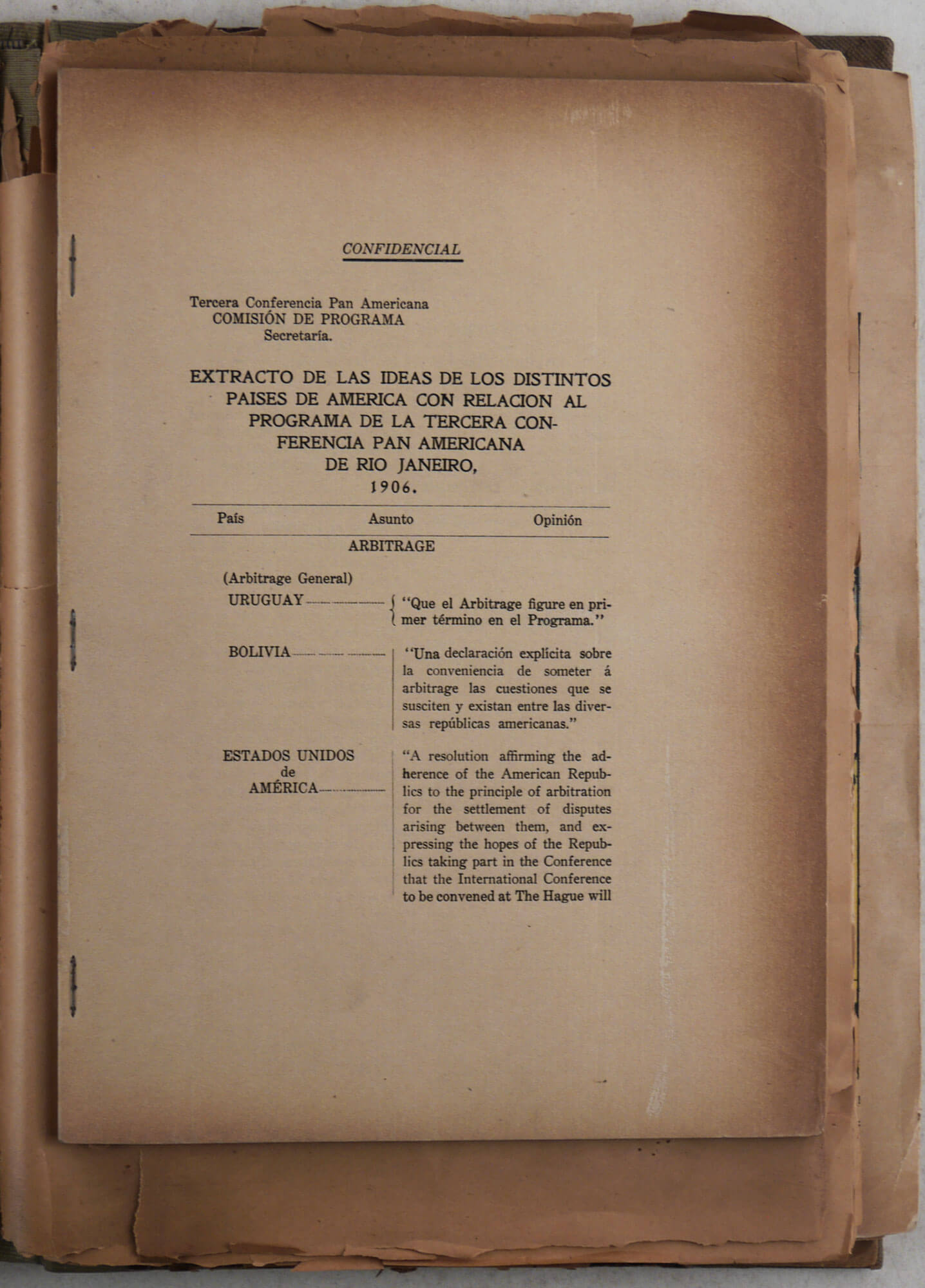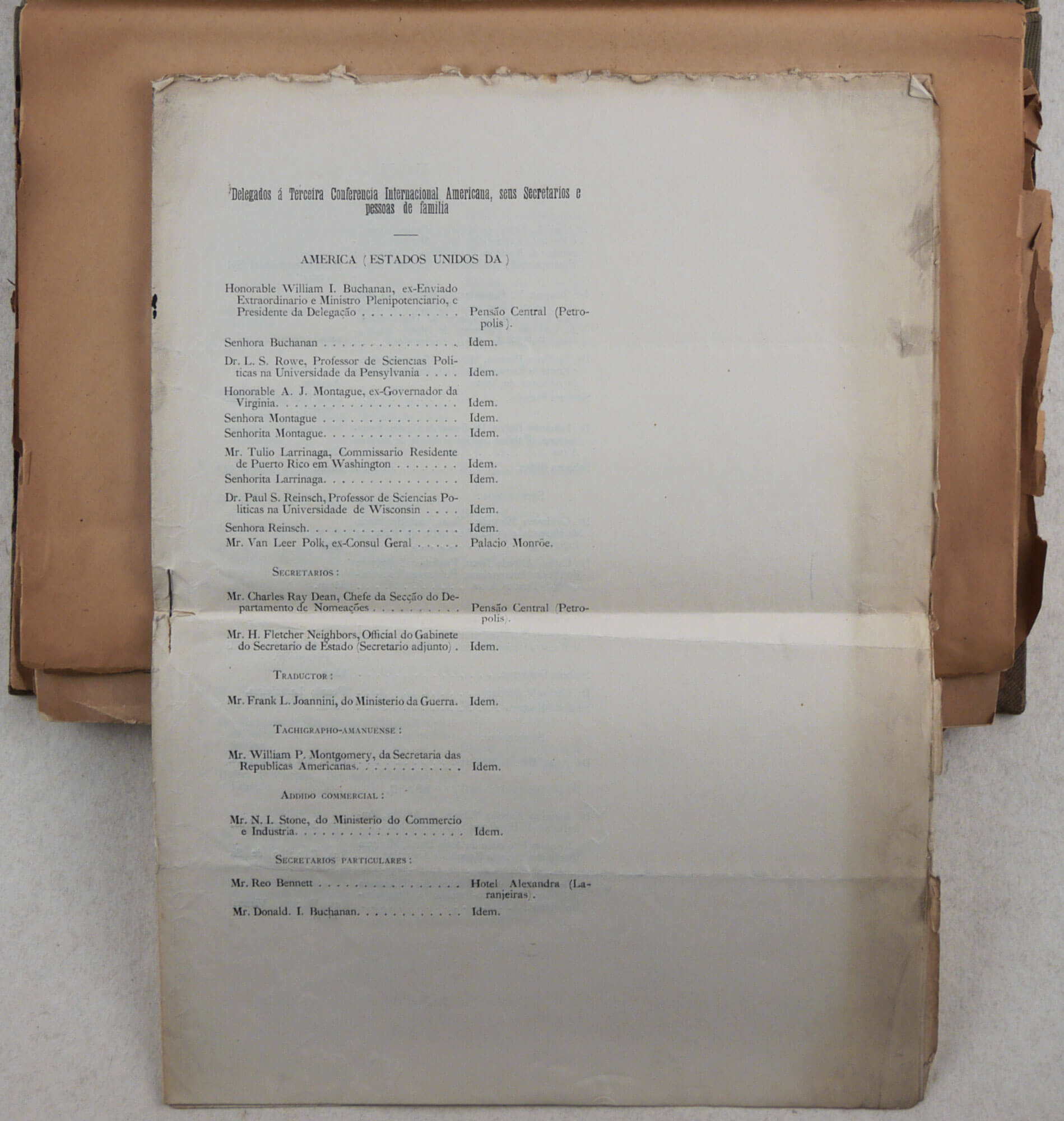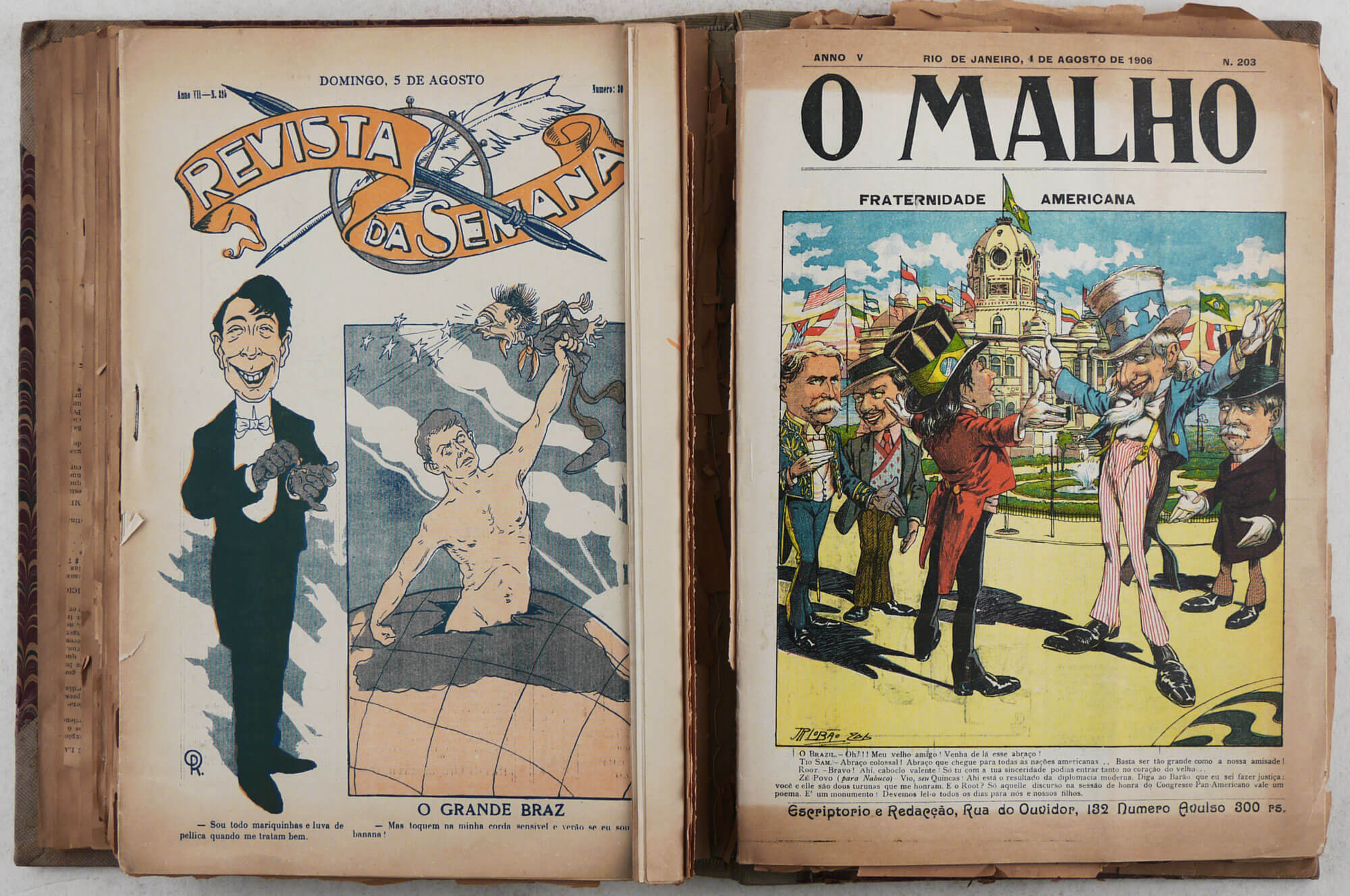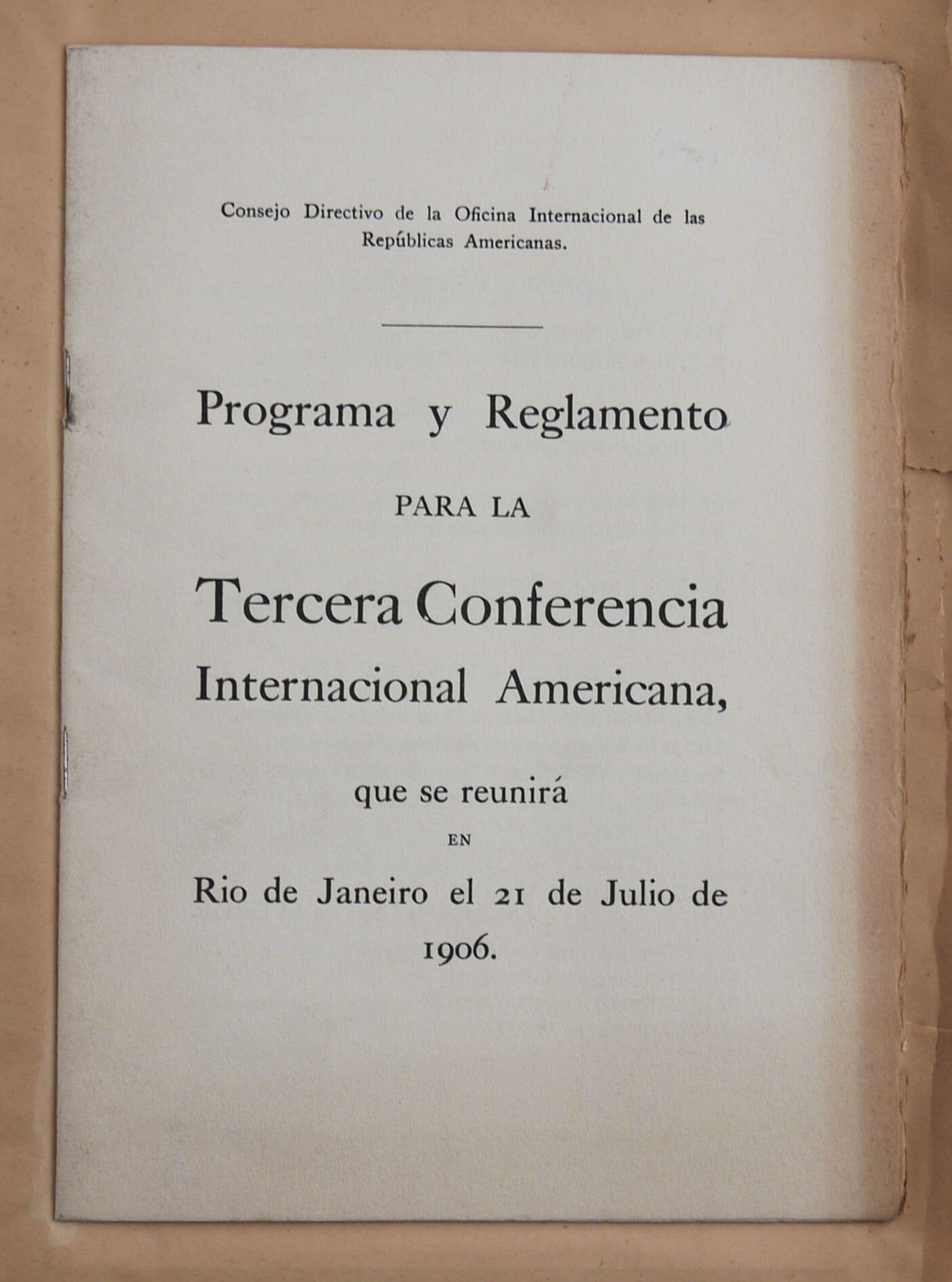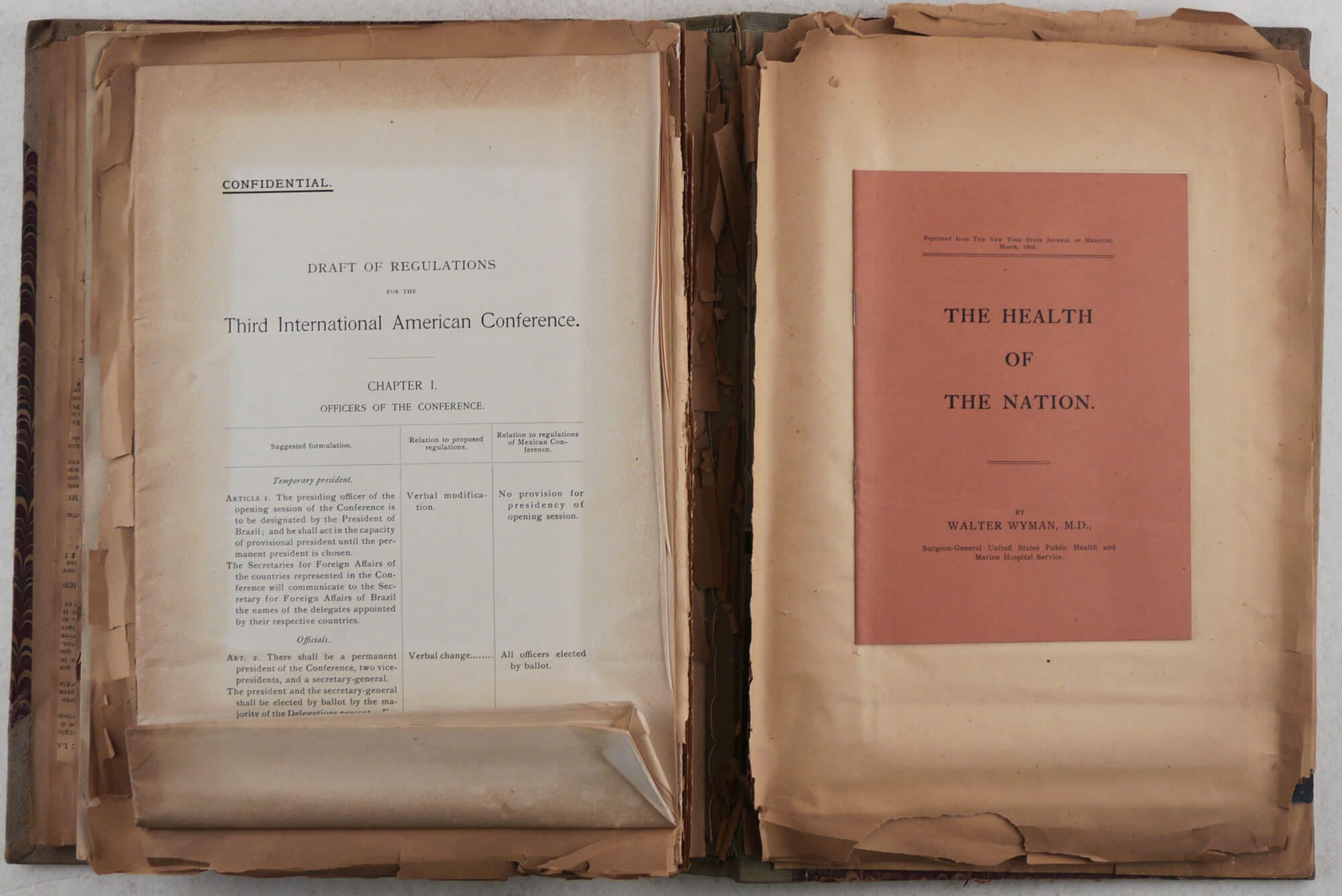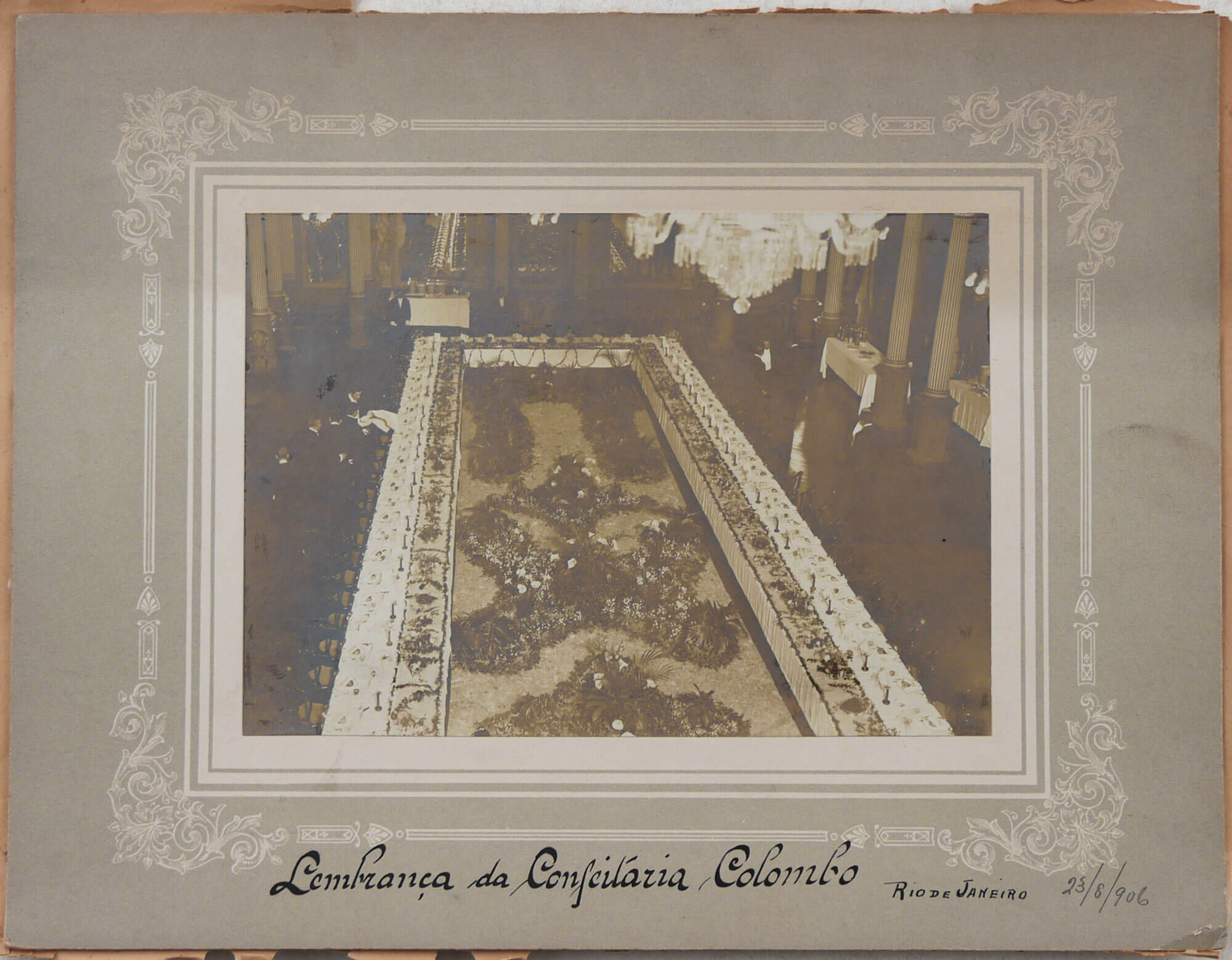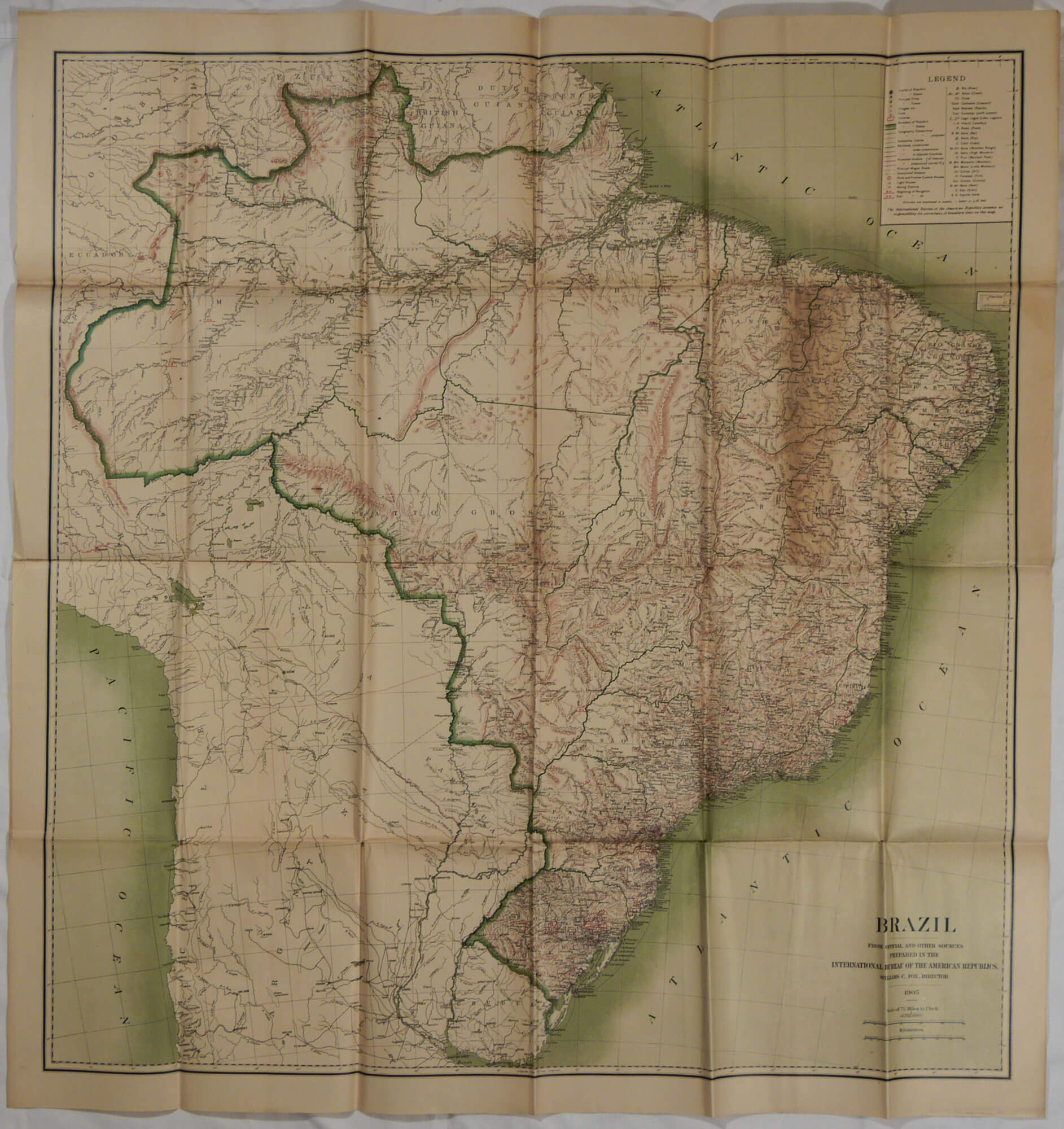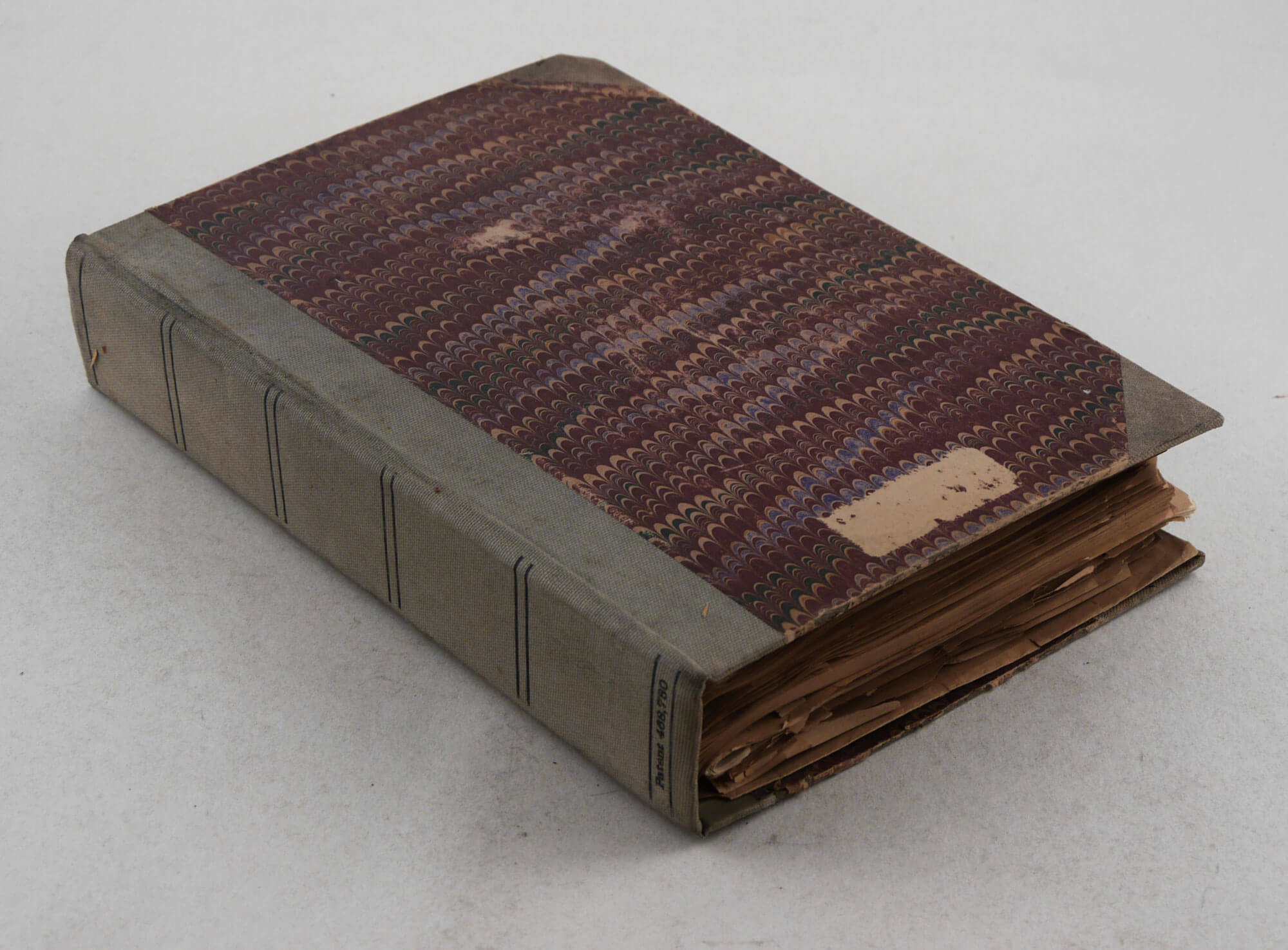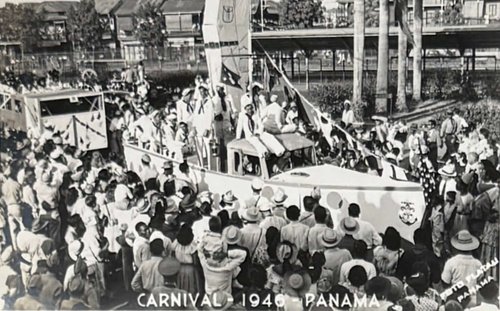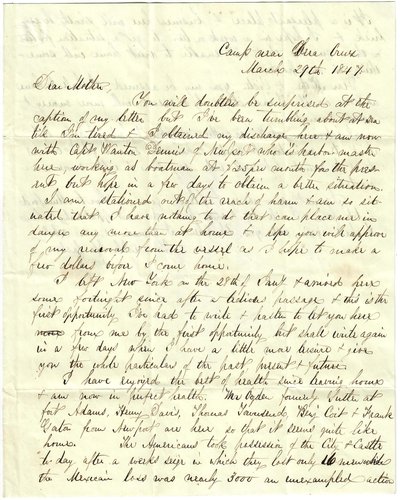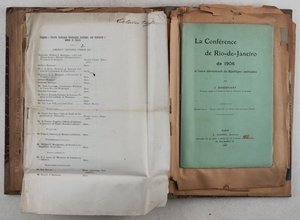
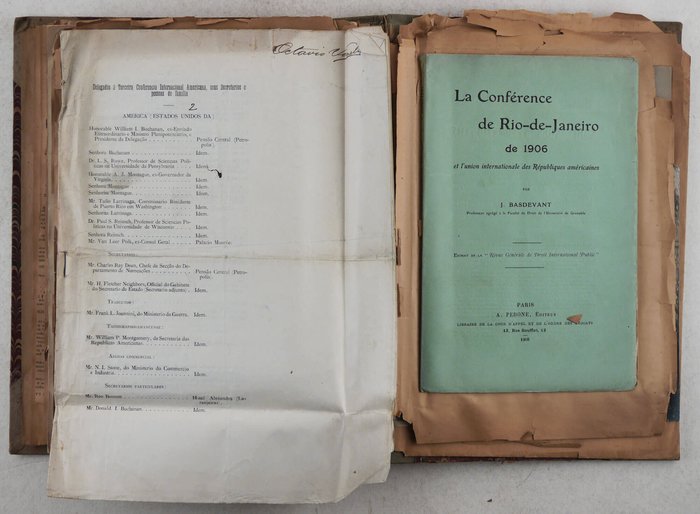



















#MC73
Ca. 1906, 1908
Folio journal/scrapbook (ca. 34x23,5 cm or 13 ¼ x 9 ¼ in). With over fifty bound-in typewritten and manuscript official documents in English and Spanish; in all over 150 pp. Over a dozen documents with official printed letterheads, including those of the White House (signed by William Loeb Jr., Secretary to the President Theodore Roosevelt), Department of State (six signed by the Secretary of State Elihu Root), International Bureau of the American Republics (signed by its Director Williams C. Fox), Treasury Department (signed by Dr. Walter Wyman), American Legation in Bogota (signed by American ambassador John Barrett), American Academy of Political and Social Science (signed by its president L.S. Rowe), University of Wisconsin Madison (signed by Professor Paul S. Reinsch), &c.
With thirteen mounted and one loosely inserted printed brochures or printed documents in English, Spanish, Portuguese and French (see the list below); in all over 370 pp. One document with Buchanan’s manuscript notes, one - with the notes of Octavio Vinelli (a secretary at the Conference), one brochure with the author’s presentation inscription to Buchanan. With over ninety mounted period American, Brazilian and Argentinian newspaper clippings. With a gelatin silver photo ca. 12x16,5 cm (4 ½ x 6 ½ in), mounted on the original card ca. 21x27 cm (8 ¼ x 10 ½ in); with a period ink caption on the mount “Lembrança da Confeitaria Colombo. Rio de Janeiro, 23/8/906.” With a loosely inserted large folding colour-printed map of Brazil ca. 102,5x96,5 cm (40 ¼ x 39 ¼ in).
Period grey half cloth with marbled papered boards. Binding slightly rubbed on extremities, mounts brittle, chipping, with tears and losses on extremities; several mounts detached and loosely inserted, several documents with creases, slightly age-toned; overall a very good journal/scrapbook.
Historically significant private archive of William I. Buchanan, a U.S. diplomat who specialized in South America, documenting his work as the head of the U.S. delegation at the Third Panamerican Conference in Rio de Janeiro (July 23 - August 27, 1906), as well as the official tour of South America of Elihu Root, the U.S. Secretary of State (in office: 1905-1909).
The First Panamerican Conference took place in 1889-1890, when the “International Union of American Republics” or the “Pan American Union” was formed. In the first half of the 20th century, the conferences were held at regular intervals (with a break during WW1); in 1948, the “Pan American Union” was restructured under the name the “Organization of American States”. The Third Panamerican Conference resulted in the continued adherence of the participants to the Arbitration Convention adopted at the First Hague Conference (1899) and invitation of them all to the Second Hague Conference (1907), reorganization of the International Bureau of American Republics; signing of several conventions (regarding naturalization; patents, copyrights and trademarks); adoption of the sanitary convention of 1905; call for the organization of a Coffee Conference in Sao Paulo; discussion of the Drago Doctrine and recommendation to further study it at the Second Peace Conference at the Hague, &c.
The U.S. Secretary of State Elihu Root was the chairman of the Third Conference’s Program and Regulations Committees and attended the Conference during his visit to Brazil on July 17 – August 7, 1906. On his tour of South America in July-September 1906, Root visited Brazil (Para, Pernambuco, Bahia, Rio de Janeiro, Sao Paulo, Santos), Uruguay (Montevideo), Argentina (Buenos Aires, Bahia Blanca), Chile (Lota, Santiago, Valparaiso), Peru (Callao, Lima), Panama (Panama City) and Colombia (Cartagena).
The documents in the journal/scrapbook include Buchanan’s correspondence with the U.S. authorities, exchanged during the preparation for the Conference and when it was held. There are original letters to and from Elihu Root (six signed by him), letters to Buchanan from the White House, the Library of Congress, the American Academy of Political and Social Science, the International Bureau of the American Republics, the U.S. Treasury Department, American Legations in Buenos Aires, Montevideo and Bogota, the Department of Political Science of the University of Wisconsin-Madison, &c. There are also several copies of memorandums and letters from the ambassadors of Latin American countries (Chile, Colombia, Uruguay, Cuba, Bolivia, Costa Rica, Brazil, &c.), sent to the International Bureau of the American Republics. The other documents include preliminary versions of the Conference’s program, a copy of a “Speech of Mr. Elihu Root delivered before the Chamber of Commerce of New York, April 28, 1893;” a copy of Buchanan’s personal letter to the President of Colombia Rafael Reyes (in office: 1904-1909); a copy of Buchanan’s letter to the American ambassador in Bogota John Barrett, &c. There are also several telegrams to Buchanan on the original printed forms, including those sent from Elihu Root, the Colombian president Rafael Reyes, Chilean Minister of the Interior Samuel Claro, and Mexican Secretary of Foreign Affairs Ignacio Mariscal.
The collection contains over ninety clippings from American, Brazilian and Argentinian newspapers, reporting about the Conference and Elihu Root’s visit to Rio de Janeiro and Buenos Aires: “New York Commercial Advertiser,” “Washington Times,” “Providence Bulletin,” “New York Sun,” “New York Herald,” “Chicago Herald,” “Buenos Aires Standard,” “Buenos Aires Herald,” “La Prensa,” “El Diaro,” “La Nacion” (all three in Buenos Aires), “Journal do Brasil,” “Journal do Commercio” (both in Rio de Janeiro) &c.
The journal/scrapbook also includes a large folding map of “Brazil: From official and other sources, prepared in the International Bureau of the American Republics. Williams C. Fox, Director. 1905.” Rich in detail, the map marks the relief and major geographical objects (mountains, rivers, lakes, bays, capes, bars, &c.), boundaries (countries and Brazilian states), towns, cities, villages, forts, telegraph lines (acting and proposed), submarine cables, railroads (acting and under construction), proposed line of the Intercontinental Railway, “principal wagon roads,” “ports and frontier custom houses,” “unexplored streams,” lighthouses, mining districts, &c. The loose gelatin silver photo shows the interior of the famous “Confeitaria Colombo” coffee house in Rio de Janeiro, with a banquet table, served for the Conference reception held on August 23, 1906 (according to the manuscript caption). Two more loose gelation silver photos of Rio by Augusto Malta show Humaita neighbourhood and the crossing of Avenida Central (Avenida Rio Branco) and Rua do Acre in downtown Rio with the building decorated with waving flags, including the flag of the United States (both photos with tears and losses to corners).
Overall an important extensive collection of original materials documenting the United States' input into the Third Panamerican Conference of 1906 and the South American tour of the U.S. Secretary of State Elihu Root.
A list of printed brochures and materials:
1) Confidencial. Extracto de las ideas de los distintos paises de America con relacion al programa de la Tercera Conderencia Pan Americana de Rio Janeiro, 1906/ Tercera Conferencia Pan Americana. Comision de Programa Secretaria. 70 pp.
2) [Three copies, one – with Buchanan’s ink and pencil markings; one – with the name and notes of Octavio Vinelli from the Secretariat of the Conference]: Delegados a Terceira Conferencia Internacional Americana, seus Secretarios e pessoas de familia. Rio de Janeiro: Imprensa Nacional, 1906. 8 pp.
3) [Illustrated magazine]: Revista a Semana: Ediçao seminal illustrada do Jornal do Brasil. Anno VII, N. 325. Domingo, 5 de Agosto [1906]. 3746-3768 [= 22] pp. Illustrated publisher’s wrappers.
4) [Illustrated magazine]: O Malho. Anno V, N. 203. Rio de Janeiro, 4 de Agosto 1906. [36] pp. Illustrated publisher’s wrappers.
5) The Pan American Conferences and their Significance. Supplement to the Annals of the American Academy of Political and Social Sciences, May 1908. Philadelphia. 22 pp. Original publisher’s wrappers.
6) Programa y Reglamento para la Tercera Conferencia Internacional Americana que se reunira en Rio de Janeiro el 21 de Julio de 1906/ Consejo Directivo de la Oficina Internacional de las Republicas Americanas. 16 pp.
7) Public Health Reports. Published in accordance with act of Congress approved February 15, 1893/ Pan-American Sanitation – Sanidad Pan-Americana. Reprint. Treasury Department – U.S. Marine Hospital Service. Washington: Government Printing Office, 1901. 13 pp.
8) Officina Internacional de las Republicas Americanas. Washington: Government Printing Office, 1906. 38 pp.
9) Confidential. Draft of Regulations for the Third International American Conference. 11 pp.
10) WYMAN, W., M.D. The Health of the Nation/ Reprinted from the New York State Journal of Medicine, March, 1905. 11 pp. Original publisher’s wrappers.
11) Regulations for the Third International American Conference. Rio de Janeiro: Imprensa Nacional, 1906. 7 pp.
12) International Bureau of the American Republics. Washington: Government Printing Office, 1906. 35 pp.
13) BASDEVANT, J. La Conference de Rio-de-Janeiro de 1906 et l’union internationale des Républiques américaines. Paris: A. Pedone, 1908. 67 pp. Original publisher’s wrappers. Author’s presentation inscription to “Monsieur Buchanan” on the first page.
14) [Loosely inserted]: [PARANHOS, Jose, Baron of Rio Branco]. Brazil, the United States and the Monroe Doctrine: Article published in the Journal do Commercio of Rio de Janeiro, January 20th, 1908. 21 pp. Original publisher’s wrappers.
Having become known for the organization of the Corn Palace Expositions in Sioux City (Iowa) in 1882, Buchanan became a member of the Iowa Commission of the World’s Columbian Exposition and in 1890, was appointed the chief of its Department of Agriculture, in 1891 – chief of its livestock and forestry department, continuing his work throughout the Exposition (May – October 1893). In 1894-1900, Buchanan served as Envoy Extraordinary and Minister Plenipotentiary in Buenos Aires, contributing to delineating the Agrentinian-Chilean boundary in the Puna de Atacama. In 1901, he was director-general of the Pan-American Exposition in Buffalo, and in 1902 – a U.S. delegate to the 2nd Pan-American Conference in Mexico, where he succeeded due to his “conciliatory attitude” and “profound and sympathetic knowledge of Latin America” ([Obituary of] William Insco Buchanan// The American Journal of International Law. Vol. 4, No. 1 (January 1910), p. 162). As a result, he became the first U.S. Envoy Extraordinary and Minister Plenipotentiary in Panama (1903-1904). In July-August 1906, Buchanan was the leader of the U.S. delegation at the Third Pan-American Conference in Rio de Janeiro. In 1907, he represented the United States at the 2nd Hague Peace Conference and the Central American Peace Conference (Washington, D.C.). In December 1908 – February 1909, in the rank of the U.S. High Commissioner to Venezuela, Buchanan negotiated two claims of a U.S. company and a citizen with the Venezuelan Foreign Minister Francisco Guinan, restoring diplomatic relations between the United States and Venezuela. To supervise the arbitration of the other cases, Buchanan went to Europe and suddenly died in London while at work in October 1909.

